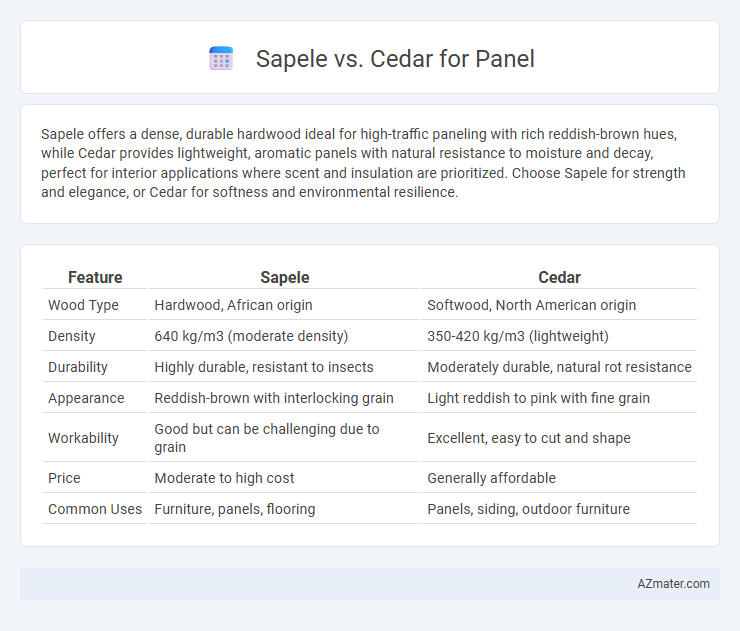Sapele offers a dense, durable hardwood ideal for high-traffic paneling with rich reddish-brown hues, while Cedar provides lightweight, aromatic panels with natural resistance to moisture and decay, perfect for interior applications where scent and insulation are prioritized. Choose Sapele for strength and elegance, or Cedar for softness and environmental resilience.
Table of Comparison
| Feature | Sapele | Cedar |
|---|---|---|
| Wood Type | Hardwood, African origin | Softwood, North American origin |
| Density | 640 kg/m3 (moderate density) | 350-420 kg/m3 (lightweight) |
| Durability | Highly durable, resistant to insects | Moderately durable, natural rot resistance |
| Appearance | Reddish-brown with interlocking grain | Light reddish to pink with fine grain |
| Workability | Good but can be challenging due to grain | Excellent, easy to cut and shape |
| Price | Moderate to high cost | Generally affordable |
| Common Uses | Furniture, panels, flooring | Panels, siding, outdoor furniture |
Introduction: Sapele vs Cedar Panels
Sapele panels offer a rich, reddish-brown hue with a fine, interlocking grain ideal for high-end cabinetry and furniture, while cedar panels provide a lighter, warm tone with natural aromatic oils that resist decay and insect damage. Sapele's durability and resistance to wear make it suitable for interior applications requiring strength, whereas cedar's lightweight and thermal insulating properties excel in exterior cladding and decorative uses. Both wood types present unique aesthetic and functional benefits, with Sapele favored for its hardwood density and cedar prized for its natural preservation qualities.
Overview of Sapele Wood
Sapele wood, a tropical hardwood from West Africa, is renowned for its rich reddish-brown color and fine interlocking grain, making it a popular choice for high-quality panels. It offers excellent durability, resistance to rot, and a smooth finish, which enhances its use in interior applications such as cabinetry and furniture. Compared to cedar, Sapele is denser and harder, providing greater structural strength and long-lasting performance in paneling projects.
Overview of Cedar Wood
Cedar wood is valued for its natural resistance to decay, insect damage, and moisture, making it an excellent choice for durable panels. Its light weight and stable grain provide a smooth finish and easy workability compared to heavier hardwoods like Sapele. The aromatic properties of cedar also contribute to a pleasant environment and natural pest repellence, enhancing panel longevity and aesthetic appeal.
Appearance and Grain Comparison
Sapele exhibits a rich reddish-brown hue with a subtle iridescence and a fine, interlocked grain pattern that creates a natural ribbon-like effect, making it highly sought after for decorative paneling. Cedar displays a lighter, more uniform color palette ranging from pale pink to deep reddish-brown, characterized by a straight, even grain that emphasizes a smooth, consistent texture. Both woods offer distinctive visual appeal, with Sapele's complex grain and warm tones contrasting against Cedar's softer color and straightforward grain structure, influencing panel choice based on desired aesthetic impact.
Durability and Longevity
Sapele offers higher durability compared to cedar, boasting strong resistance to decay, insects, and moisture, making it ideal for long-lasting wooden panels. Cedar's natural oils provide moderate protection against rot and insect damage, but it is softer and more prone to dents and scratches over time. For longevity in panel applications, Sapele is preferred due to its dense hardwood properties and superior wear resistance.
Workability and Ease of Use
Sapele offers excellent workability with a fine, interlocked grain that machines smoothly and holds detail well, making it ideal for intricate panel designs. Cedar, known for its softness and lightweight characteristics, is easier to cut and shape but may dent or scratch more readily during use. Both woods provide ease of use, but Sapele's durability and resistance to wear give it an advantage for high-traffic panel applications.
Resistance to Moisture and Decay
Sapele wood demonstrates superior resistance to moisture and decay compared to cedar, making it ideal for paneling in high-humidity environments. Its dense, interlocked grain structure reduces water absorption and resists fungal attacks better than the softer, more porous cedar. While cedar offers natural oils that provide moderate decay resistance, Sapele's higher durability ensures longer-lasting panel performance in wet or damp conditions.
Cost and Availability Analysis
Sapele wood typically costs less than cedar due to its wider availability in West Africa and strong supply chains supporting its export. Cedar, especially Western Red Cedar, tends to be pricier because of its limited geographic sources in North America and higher demand for premium outdoor paneling. Both woods vary considerably in cost based on grade and board dimensions, but Sapele generally offers better value for larger projects requiring abundant material.
Sustainability and Environmental Impact
Sapele wood is sourced primarily from West African forests, where sustainable harvesting practices are increasingly implemented to reduce deforestation and habitat loss. Cedar, particularly Western Red Cedar, is often harvested from North American managed forests with certifications like FSC promoting responsible forestry and carbon sequestration benefits. Both woods offer renewable options for paneling, but Sapele's slower growth rate may impact long-term sustainability compared to faster-growing cedar species.
Which Wood is Best for Panels?
Sapele and cedar both offer unique advantages for paneling, but sapele's dense grain and rich reddish-brown color provide superior durability and aesthetic appeal for high-end interior panels. Cedar is valued for its natural resistance to moisture and insects, making it ideal for damp or outdoor environments. For indoor decorative panels requiring longevity and a luxurious finish, sapele is the best choice, while cedar excels in settings where natural protection is a priority.

Infographic: Sapele vs Cedar for Panel
 azmater.com
azmater.com